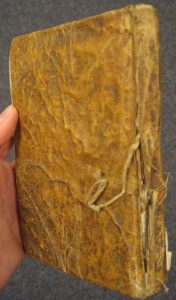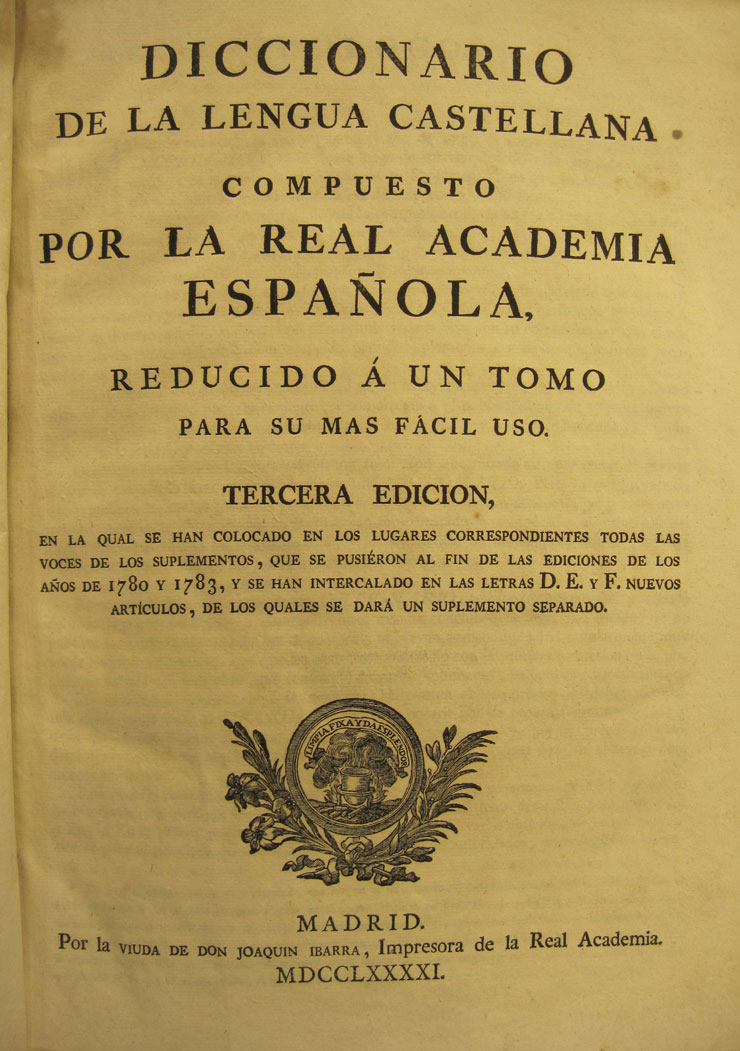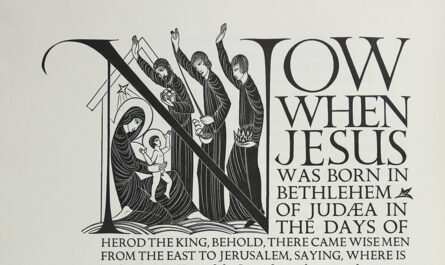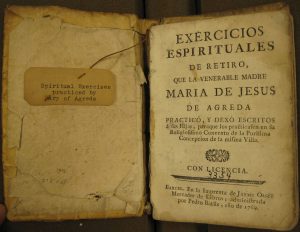
The Ignatian Spiritual Exercises tend to take the spotlight at a Jesuit institution, but it was another book of exercises that caught my attention as I explored the Spanish language items in the stacks. Before picking up María de Ágreda’s Exercicios Espirituales de Retiro (1769), I had yet to encounter a set of spiritual exercises written by a woman. Adding to my curiosity was the small slip of cut-up envelope tucked inside the volume that reads, “This book was found in a cave near the ruins of an old Dominican monastery in Sonora, Mexico.” I wondered how this edition published in Barcelona ended up in a cave in Mexico, and I was eager to trace the origins of the book and its author.
By consulting works from the general collection and corresponding with the author of the recently published biography María of Ágreda: Mystical Lady in Blue, I learned that the Exercicios were not only written by a woman, but by one of the most prominent mystics of the seventeenth century. The author was a cloistered Franciscan Conceptionist nun known for her mystic spirituality, bilocation in Mexico and west Texas, levitation and trances during prayer, polemical writing, interrogation by the Spanish Inquisition, role as spiritual and political advisor to King Felipe IV, and incorrupt body. In addition, I discovered that one of her publications, Mística Ciudad de Dios, was cited as an authoritative source in standard Spanish language usage in the Real Academia Española’s first Diccionario (see my earlier post on our copy of the third edition). María’s roles as mystic and as influential published author struck me as unusual for a seventeenth-century woman, especially a cloistered nun.
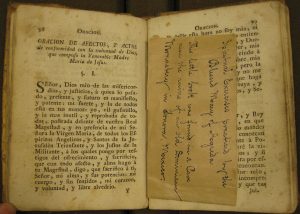
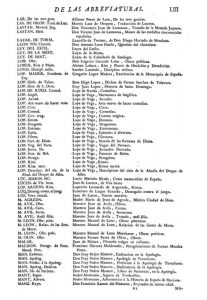
Mística Ciudad de Dios (Mystical City of God), María’s most famous publication and the one that made her a Spanish language authority at the time, also established her as a controversial figure. This biography of Mary was completed in 1645, burned in the same year by order of María’s temporary confessor, and rewritten between 1655 and 1660. No doubt the controversy surrounding Mística Ciudad de Dios and its me on the Church’s Index Librorum Prohibitorum prompted the Licencia de la orden in her later Exercicios, which assures readers that the work has been examined by the Theologian of the Order, and “no contiene cosa contra la Santa Fè Catholica, ni buenas costumbres.” (does not contain anything against the Holy Catholic Faith, nor against good moral values).
María’s reported bilocation and widespread religious following in Mexico and west Texas earned her the attention of King Felipe IV of Spain, who sought her out as a spiritual and political advisor. They corresponded by letter beginning in 1643; over the next twenty-two years, six hundred exchanges passed between María’s convent and the King, all in the utter secrecy he demanded. Many of their exchanges consisted of the King’s writing his problems on the right side of the page and María’s responding to each of them in the left margin.
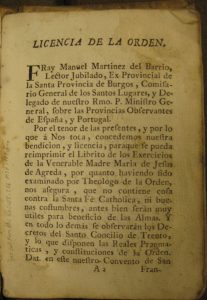
Our copy of Exercicios Espirituales de Retiro is as humble as María is described to be, and has survived generations and institutions. Its binding is wrinkled and withered, perhaps from the arid climate of Sonora. A small piece of paper attached with string to the book’s spine gives the title and author, and was presumably meant to be hung outside of the book allowing readers to identify the work without having to open it. The humble body of the book was cared for with multiple repairs to the spine in green and white thread.
The book’s missing final leaf reminded me of the larger mystery surrounding its travels from Barcelona to Sonora to our collection here in St. Louis. I learned there were around 69 Dominican and 172 Franciscan monasteries established in Mexico and the Southwest by the year 1612, eight years before María reported her bilocation encouraging missionaries in their work. After discovering this, it does not surprise me that a volume of her Exercicios espirituales would be found in the area. The question I am left pondering is: how did her book get from a cave in Mexico onto my desk in Rare Books?

 by
by 